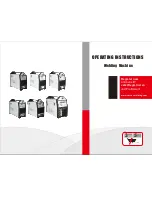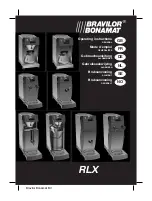
Part No. 729-110-037 Rev. 1.31 | May 2016
© 2014 Nelson Stud Welding, Inc. All Rights Reserved.
WARNING
The following Safety section is
for your protection. It
summarizes precautionary
information from the references
listed in the Additional Safety Information section.
Before performing
any installation or operating procedures, be sure to read and follow the
safety precautions listed below as well as all other manuals, material
safety data sheets, labels, etc. Failure to observe these precautions can
result in injury or death.
ELECTRICAL SHOCK
Contact with live electrical parts and ground can cause
severe injury or death. DO NOT use welding current in
damp areas, if movement is confined, or if there is
danger of falling. Faulty or improperly electrified
equipment can cause injury or death. Therefore:
1.
Always have qualified personnel perform the installation, troubleshooting,
and maintenance work unless you are qualified to perform such work.
2.
Install equipment in accordance with the U.S. National Electrical Code, all
local codes and the manuf
acturer’s recommendations.
3.
Be sure the power source frame (chassis) is connected to the ground
system of the input power.
4.
Connect the work piece to a good electrical ground.
5.
Connect the work cable to the work piece. A poor or missing connection
can expose you or others to a fatal shock.
6.
Use well-maintained equipment. Replace worn or damaged cables.
7.
Keep everything dry, including clothing, work area, cables, torch/electrode
holder and power source.
8.
Make sure that all parts of your body are insulated from work and from the
ground.
9.
Do not stand directly on metal or the earth while working in tight quarters or
a damp area; stand on dry boards or an insulating platform and wear
rubber soled shoes.
10. Put on dry, hole-free gloves before turning on the power.
11. Refer to ANSI/ASC Standard Z49.1 for specific grounding
recommendations. Do not mistake the work lead for a ground cable.
12. Before performing any work inside a power source, disconnect the power
source from the incoming electrical power using the disconnect switch at
the fuse box before working on the equipment.
PROTECT YOURSELF AND OTHERS
Some welding, cutting, and gouging processes are
noisy and require ear protection. The arc, like the
sun, emits ultraviolet (UV) rays and other radiation
which can harm the skin and eyes. Hot metal can
cause burns. Training in the proper use of the
processes and equipment is essential to prevent
accidents. Therefore:
1.
Always wear safety glasses with side shields in any work area, even if
welding helmets, face shields and goggles are also required.
2.
Use a face shield fitted with filter shade #3 per ANSI Z87.1. Cover
sparks and rays of the arc when operating or observing operations.
Warn bystanders not to watch the arc and not to expose themselves
to the rays of the electric-arc or hot metal.
3.
Wear flameproof gauntlet type gloves, heavy long-sleeve shirt,
cuffless trousers, high topped shoes, and a welding helmet or cap for
hair protection, to protect against arc rays and hot sparks or hot metal.
A flameproof apron may also be desirable as protection against
radiated heat and sparks.
4.
Hot sparks or metal can lodge in rolled up sleeves, trousers cuffs or
pockets. Sleeves and collars should be kept buttoned and open
pockets eliminated from the front of clothing.
5.
Protect other personnel from arc rays and hot sparks with suitable
nonflammable partitions or curtains.
6.
Use goggles over safety glasses when chipping slag or grinding.
Chipped slag may be hot and can fly far. Bystanders should also wear
goggles over safety glasses.
ELECTRICAL AND MAGNETIC FIELDS
Electric and magnetic fields may be dangerous. Electric
current flowing through any conductor causes localized
Electric and Magnetic Fields (EMF). Welding and cutting
current creates EMF around welding cables and welding
machines. Therefore:
1.
Operators having pacemakers should consult their physician before
welding. EMF may interfere with some pacemakers.
2.
Exposure to EMF may have other health effects which are unknown.
3.
Operators should use the following procedures to minimize exposure to
EMF:
4.
Route the electrode and work cables together. Secure them with tape when
possible.
5.
Never coil the torch or work cable around your body.
6.
Do not place your body between the torch and work cables. Route cables
on the same side of your body.
7.
Connect the work cable to the work piece as close as possible to the area
being welded.
8.
Keep welding power source and cables as far away from your body as
possible.
FIRES AND EXPLOSIONS
Heat from flames and arcs can start fires. Hot
slag or sparks can also cause fires and
explosions. Therefore:
Remove all combustible materials well away from the work area or
cover the materials with a protective nonflammable covering.
Combustible materials include wood, cloth, sawdust, liquid and gas
fuels, solvents, paints and coatings, paper, etc.
Hot sparks or hot metal can fall through cracks or crevices in floors
or wall openings and cause a hidden smoldering fire or fires on the
floor below. Make certain that such openings are protected from hot
sparks and metal.
Do not weld, cut, or perform other hot work until the work piece has
been completely cleaned so that there are no substances on the
work piece which might produce flammable or toxic vapors. Do not
do hot work on closed containers. They may explode.
Have appropriate fire extinguishing equipment handy for instant
use, such as a garden hose, water pail, sand bucket or portable fire
extinguisher. Be sure you are trained for proper use.
Do not use equipment beyond its ratings. For example, overloaded
welding cable can overheat and create a fire hazard.
After completing operations, inspect the work area to make certain
there are no hot sparks or hot metal which could cause a later fire.
Use fire watchers when necessary.
For additional information, refer to NFPA Standard 51B, “Fire
Prevention in Use of Cutting and Welding Processes,” available
from the National Fire Protection Association, Batterymarch Park,
Quincy, MA 02269
MOVING PARTS CAN CAUSE INJURY
Electric fan can start at any time without warning and
cause severe injury, therefore:
1.
Always disconnect electrical power prior to service to prevent the fan from
starting unexpectedly.
2.
Keep all doors, panels, covers, and guards closed and securely in place.
3.
Have only qualified people remove guards or covers for maintenance and
troubleshooting as necessary.
4.
Keep hands, hair, loose clothing, and tools away from moving parts.
5.
Reinstall panels or guards and close doors when servicing is finished and
before reenergizing welder.




































